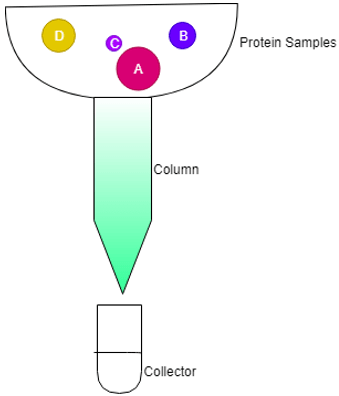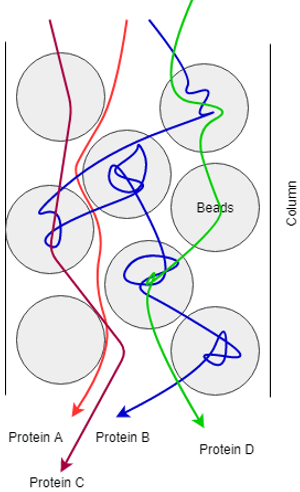This set of Biophysics Multiple Choice Questions & Answers (MCQs) focuses on “Molecular Exclusion Chromatography”.
1. Which of the following is not a molecular exclusion chromatography?
a) Size exclusion
b) Gel filtration
c) Molecular sieve
d) Adsorption
View Answer
Explanation: Adsorption is not a molecular exclusion chromatography. Size exclusion, gel filtration and Molecular sieve chromatography are the synonyms of molecular exclusion chromatography.
2. Size exclusion chromatography is based on the charge difference of the molecules.
a) True
b) False
View Answer
Explanation: Size exclusion chromatography is completely based on the differences in the size of the samples or proteins. The column is made of porous beads thus the proteins get separated on the basis of their size not based on their charge.
3. You have three proteins with size 8kd, 10kd, 12kd, 6kd respectively. You performed Size exclusion chromatography in S-medium bead size. Which of the protein will elute first and which one will be the last eluted protein?
a) 6kd protein will be eluted first and 12kd protein will be eluted last
b) 12kd protein will be eluted first and 6kd protein will be eluted last
c) 6kd protein will be eluted first and 10kd protein will be eluted last
d) 12kd protein will be eluted first and 8kd protein will be eluted last
View Answer
Explanation: In a Size exclusion chromatography, the beads used in the column is porous. Thus the smaller proteins get inside the beads and takes longer time to elute. Therefore, the 6kd protein will be eluted first and 12kd protein will be eluted last.
4. Which of the following material is most commonly used to make Size exclusion chromatography gel?
a) Dextran
b) Agar
c) CM-cellulose
d) DEAE-cellulose
View Answer
Explanation: Dextran is most commonly used to make Size exclusion chromatography gel as it makes a rigid, nonreactive and porous bead. The rest of the material produces charged bead which may interact with the protein molecules.
5. Consider the following image as a hypothetical demonstration of gel exclusion chromatography. If the protein is the same as shown in the image. Determine the order of the elusion in from first to last.

a) A>C>D>B
b) A>B>D>C
c) A>D>B>C
d) C>B>D>A
View Answer
Explanation: In a gel exclusion chromatography, the column is made up of porous beads. Thus the smaller proteins travel inside the beads and take longer time to elute. Whereas the larger proteins bypass the porous bead and elute faster.
6. Gel exclusion chromatography is based on the difference of _______________
a) molecular weight
b) size
c) charge of the proteins
d) secondary structure of the protein
View Answer
Explanation: Gel exclusion chromatography is based on the difference in size. The column for this chromatography is composed of porous beads which are the key factor for protein separation based on size. This column doesn’t separate proteins based on other factors.
7. If the total bed volume of a size exclusion chromatography is 105cc and void volume is 35cc, then what will be the volume if the occupied by gel beads?
a) 140 cc
b) 3 cc
c) 70cc
d) 200 cc
View Answer
Explanation: We know, Vt = Vx + V0, where Vt means total bed volume, Vx means bead volume and V0 is void volume. Therefore, void volume is 105cc – 35cc = 70cc.
8. In a gel filtration chromatography, you pour 65cc buffer to the column to completely fill it. Now you have already calculated the total column volume 144 cc. What is the bead volume present inside the column?
a) 209 cc
b) 79cc
c) 2 cc
d) 400 cc
View Answer
Explanation: Here 65cc means the free space or void volume inside the column. The total volume of the column is given as 144cc. Therefore, the bead volume is 144 – 65cc = 79cc.
9. You have a 95cc column of size exclusion chromatography. Suppose no buffer is given to you. If it’s completely filled with dextran bead, what will be the approximate void volume of the column?
a) 95cc
b) 47.5 cc
c) 33cc
d) 20 cc
View Answer
Explanation: Void volume is always approximately 35% of the total volume. Therefore, 35% of 95 cc is 33 cc which is the void volume of that column.
10. You have 4 proteins with size 2kd, 6kd, 12kd, 30kd. You have performed a size exclusion chromatography as shown below. Based on this image, identify the following proteins.

a) Protein B = 2kd, Protein D = 6kd, Protein C =12kd, Protein A = 30kd
b) Protein B = 6kd, Protein D = 2kd, Protein C =12kd, Protein A = 30kd
c) Protein B = 2kd, Protein D = 12kd, Protein C =12kd, Protein A = 30kd
d) Protein B = 2kd, Protein D = 6kd, Protein C =30kd, Protein A = 12kd
View Answer
Explanation: The size exclusion chromatography column is composed of porous beads. If the protein is small, it will go into the beads and moves slowly. Therefore, elusion time is inversely proportional to the protein size.
11. Which of the following beads can be used to separate proteins with 50kd, 80kd and 30kd?
a) Sephadex G- 10
b) Sephadex G- 25
c) Sephadex G- 50
d) Sephadex G-100
View Answer
Explanation: The standard elusion range of Sephadex G-100 is 4-150KD. Therefore, it is suitable for the separation of the above-mentioned proteins. Whereas, the rest of the beads are used to separate smaller sized proteins.
12. You need to separate 4 proteins which are less than 5kd. Which of the following beads will you choose for elution?
a) Sephadex G- 10
b) Sephadex G- 25
c) Sephadex G- 50
d) Sephadex G-100
View Answer
Explanation: Among the above options, Sephadex G- 25 is the widely used beads for the separation of 5kd proteins. Whereas Sephadex G- 50 and G – 100 is used for the separation of larger protein and G – 10 is used for the separation of proteins < 1kd.
13. What is the shape of the size exclusion chromatography beads?
a) Square
b) Circular
c) Spherical
d) Triangular
View Answer
Explanation: The beads are spherical in nature to maximize the occupied volume. It’s not in the other shape because that will reduce its volume.
14. Which of the following type of beads are most precise, smaller and costly?
a) Sephadex G- 10
b) Sephadex G- 25
c) Sephadex G- 50
d) Sephadex G-100
View Answer
Explanation: Among the following Sephadex G-10 is made to separate proteins < 1kd. Therefore, the porosity of these beads is maximum as well as the size of the pore is minimum. Therefore, this type of beads is most precise, smaller and costly.
15. Rearrange the following beads accoding to their increasing bead size and porosity – Sephadex G – 10, Sephadex G – 25, Sepharose 4B, Sephadex G – 100.
a) Sephadex G – 10 < Sephadex G – 25 < Sephadex G – 100 < Sepharose 4B
b) Sephadex G – 25 < Sephadex G – 10 < Sephadex G – 100 < Sepharose 4B
c) Sepharose 4B < Sephadex G – 10 < Sephadex G – 25 < Sephadex G – 100
d) Sephadex G – 10 < Sephadex G – 100 < Sephadex G – 25 < Sepharose 4B
View Answer
Explanation: Sepharose 4B is the cheapest bead which is used to separate proteins more than 20000Kd. whereas the Sephadex G bead’s bead size increase with its suffix numeric.
Sanfoundry Global Education & Learning Series – Biophysics.
To practice all areas of Biophysics, here is complete set of 1000+ Multiple Choice Questions and Answers.
If you find a mistake in question / option / answer, kindly take a screenshot and email to [email protected]
